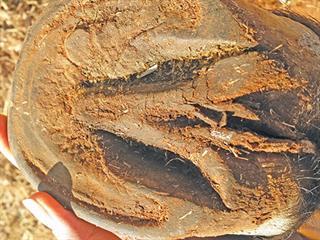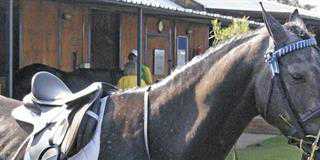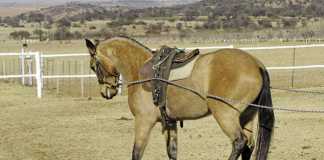
Being involved with horses all the time, I seldom wear anything other than boots. I cannot imagine running around in a pair of high heels all day. Unfortunately, most of the horses I see are just as uncomfortable in their shoes – and they’re nailed to them! All I want to do is take off their shoes and put bigger and more comfortable ones on.
Many horses in South Africa are stabled far from their farriers. This means that many are shod a size smaller in the hope that they will not shed a shoe before the farrier comes round again. This is not a good idea, and understanding the horse’s foot will explain why. It will also help to prevent a lame horse, and save you money.
The sole
Picking up from the previous article, let’s continue with our examination of the sole. Its surface should be concave, calloused and about as wide as it is long. The space under the distal rim of the coffin bone should be 12mm to 15mm thick. This will effectively protect the coffin bone from trauma. Determining the sole’s thickness involves more of a ‘prediction’ than an exact measurement.
Place a ruler in the collateral sulci at the top of the frog and measure the distance between the deepest part of the sulci and the bottom of the hoof. If the horse has thin soles, there will be very little or no depth to the collateral sulci at the top of the frog.
Horses with zero collateral groove depth here generally have a sole depth of less than 7mm. This means that the horse is susceptible to bruising of the sole, subsolar infection, changes in the coffin bone and even rim fractures.
Ensuring healthy hooves
Now that we have a comprehensive understanding of how hooves work, we can ensure they are kept healthy. Start by blending seaweed and rose hip, and feeding this to your horse. Rose hip is very high in biotin and helps to ensure good quality hooves. It also contains vitamins C, E, K and nicotinamide, and makes a good tonic for an ill horse or one recovering from illness.
It is my experience that horses suffering from liver-based illnesses – laminitis or biliary, for example – recover faster after being given rose hip. About 35g/ day ground up in normal feed works wonders. Horses suffering from thrush due to a cracked heel have also responded well after being fed dried rose hips. Cold pressed rose hip oil is also a remarkable hoof dressing. Apply a small amount of oil to the coronary band twice a week. This helps stimulate growth and gives the hoof suppleness, preventing excessive chips and cracks.
Another effective natural substance is kelp powder. This is highly palatable and rich in minerals such as calcium, iodine and potassium. Even the fussiest eater will enjoy a scoop of kelp over its feed. Kelp is especially useful when you are feeding horses with little access to good grazing. It will help put weight on a horse recovering from illness or very hard exercise. Feed around 50g/day, but no more. It does not matter if the kelp is fresh or dry – the dosage remains the same.
Horses that suffer from brittle, slow- growing hooves will also benefit from kelp. Finally, be patient. Hooves take a while to grow out healthy, but it’s well worth the wait.













